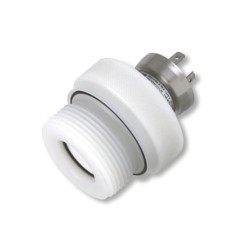 There are a number of methods and technologies for measuring the level of a fluid with hydrostatic pressure transducers, all of them have advantages and disadvantages depending on the installation. Measuring hydro-statically is an accurate and convenient technique for determining fluid height or volume.
There are a number of methods and technologies for measuring the level of a fluid with hydrostatic pressure transducers, all of them have advantages and disadvantages depending on the installation. Measuring hydro-statically is an accurate and convenient technique for determining fluid height or volume.
Hydrostatic pressure transducers are very similar to pneumatic or hydraulic pressure transducers in the way pressure is measured, but there are some differences which are specific to liquid level measurement.
External Mounted Level Sensors
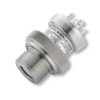 If measuring the contents of a tank it maybe possible to mount a hydrostatic level transducer to the outside of the vessel via a threaded or flange fitting. The type of mount will depend on what is already available on the tank, but a suitable adaptor could be used if the fitting is not one that is typically available on hydrostatic level sensors. To avoid trapped air and trapped residues, it is best to use a hydrostatic level transmitter which has an open fitting exposing the sensing diaphragm. Since the pressure range required for measuring the head of liquid in a tank is often a relatively low one compared to pneumatic and hydraulic ranges, the size of the sensor can be up to a few inches in diameter to accommodate a larger surface area diaphragm.
If measuring the contents of a tank it maybe possible to mount a hydrostatic level transducer to the outside of the vessel via a threaded or flange fitting. The type of mount will depend on what is already available on the tank, but a suitable adaptor could be used if the fitting is not one that is typically available on hydrostatic level sensors. To avoid trapped air and trapped residues, it is best to use a hydrostatic level transmitter which has an open fitting exposing the sensing diaphragm. Since the pressure range required for measuring the head of liquid in a tank is often a relatively low one compared to pneumatic and hydraulic ranges, the size of the sensor can be up to a few inches in diameter to accommodate a larger surface area diaphragm.
Immersed Level Sensors
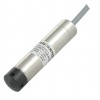 If it is not possible to use a sensor mounted to the outside, a submersible pressure sensor will have to be lowered into the liquid instead. An IP68 rated electrical connection suitable for long term permanent immersion protects the sensor’s electronics from the external environment.
If it is not possible to use a sensor mounted to the outside, a submersible pressure sensor will have to be lowered into the liquid instead. An IP68 rated electrical connection suitable for long term permanent immersion protects the sensor’s electronics from the external environment.
Featured hydrostatic pressure transducer products
 Underground rain water storage tank level sensor and readout for 2 metre depth - Water level indicator for a 2 metre deep rain water storage tank located underground.
Underground rain water storage tank level sensor and readout for 2 metre depth - Water level indicator for a 2 metre deep rain water storage tank located underground. 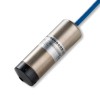 LMK458 Marine Approved Hydrostatic Level Transmitter - Marine approved level transmitter with 4-20mA output for measuring level of contents inside ship ballast, fuel, liquid cargo or wastewater tanks
LMK458 Marine Approved Hydrostatic Level Transmitter - Marine approved level transmitter with 4-20mA output for measuring level of contents inside ship ballast, fuel, liquid cargo or wastewater tanks
Corrosion Protection
Some liquids will limit the choice of materials used in the sensor construction due to their corrosive properties. To optimise compatibility with more aggressive media, level sensors are made from a variety of materials which are particularly suited to certain applications such as:
- Stainless Steel 316 (Fresh Water, Wastewater, Fuel, Oils, Food, Beverage)
- Super Duplex Stainless Steel (Seawater, Brackish Water)
- Hastelloy C276 (Seawater, Brackish Water)
- PVC (Most Chemicals)
- PVDF (Most Chemicals)
- Titanium (Seawater, Brackish Water)
- Ceramic / Al2O3 / Aluminium Oxide (Most Chemicals)
- Teflon / PTFE (Seawater, Chemicals)
- Polyurethane / PUR (Fresh Water)
- Viton / FKM (Petrol, Gasoline, Diesel, Kerosene, Alcohols)
- EPDM (Diluted Acids, Alkalis, Alcohols)
- NBR / Buna N (Oils, Fuel Oils)
- Kalrez / FFKM (Concentrated Acids, Alkalis)
Sensor Positioning
A pressure sensor will measure the head of fluid directly above the sensor location. As long as the sensor is positioned no higher than the lowest expected level, the sensor can be installed anywhere between the minimum level and the bottom. The closer the pressure range matches the variation in level the more accurate will be the measurement.
e.g. The water level of a 10 metre high tank will never drop below 5 metres, a 0.25% FS accuracy sensor with a 10 metre of water range will measure to a precision of 25mm and a 5 metre of water range would measure to a precision of 12.5mm.
When mounting externally it is preferable to position the sensor away from feed lines where there could be differential pressures generated by flowing liquid which might affect the hydrostatic level reading. If there is a large amount of particle residue at the bottom of the tank avoid mounting too close to the bottom to avoid clogging of the pressure transducer process connection.
Featured hydrostatic pressure transducer products
 Dirty water, sludge & sewerage tank level 400 mbar pressure sensor - Flush ceramic diaphragm pressure sensor for measuring level of a dirty water, sludge & sewerage tank.
Dirty water, sludge & sewerage tank level 400 mbar pressure sensor - Flush ceramic diaphragm pressure sensor for measuring level of a dirty water, sludge & sewerage tank.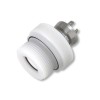 4-20mA Output Hydrostatic Level Transmitters & Sensors - Explore industrial 4-20mA hydrostatic level transmitters for reliable liquid depth measurement. Ideal for tank gauging, borehole control & process monitoring applications.
4-20mA Output Hydrostatic Level Transmitters & Sensors - Explore industrial 4-20mA hydrostatic level transmitters for reliable liquid depth measurement. Ideal for tank gauging, borehole control & process monitoring applications.
Hydrostatic Pressure Units
In order to relate the hydrostatic pressure measured to a level reading a sensor will be marked and scaled in Metres of Water (mH2O, mWG or mWC) or Feet of Water (ftH2O, ftWG or mWC).
Hazardous Areas
On sites such as refineries or fuel storage depots there are extra considerations for safety due to the presence of flammable gases. For these types of sites it is often a requirement to install intrinsically safe hydrostatic pressure transducers. In Europe this is controlled by ATEX regulations and certifications.
Specific Gravity
Different liquids vary in density when compared with water and this difference is distinguished using Specific Gravity (SG) where the reference is freshwater which has a designated SG of 1. To determine the required pressure range in mH2O of ftH2O, the actual maximum level should be multiplied by the Specific Gravity of the fluid being measured.
Help
Laying sensor on its side
I have to measure a change in water level over 3 days where the maximum depth is 4 inches. Is it possible to lay a sensor on its side?
Any pressure sensor can be laid on it’s side, and the pressure generated by the liquid column should be measured from the centre of the diaphragm. Also low range pressure sensors are sensitive to orientation due to the pull of gravity, so you may need re-calibrate the zero offset when changing the orientation.
Featured hydrostatic pressure transducer products
 Chemical Resistant Hydrostatic Liquid Level & Pressure Sensors - Find durable hydrostatic liquid level and pressure sensors designed for harsh chemical environments. Ideal for storage tanks and process applications requiring high corrosion resistance.
Chemical Resistant Hydrostatic Liquid Level & Pressure Sensors - Find durable hydrostatic liquid level and pressure sensors designed for harsh chemical environments. Ideal for storage tanks and process applications requiring high corrosion resistance. Contaminated groundwater submersible plastic body 5 psi pressure transducer & display - This submersible pressure transducer and display can be used by landfill site pump techs to read leachate water level above the transducer at the well head.
Contaminated groundwater submersible plastic body 5 psi pressure transducer & display - This submersible pressure transducer and display can be used by landfill site pump techs to read leachate water level above the transducer at the well head.
